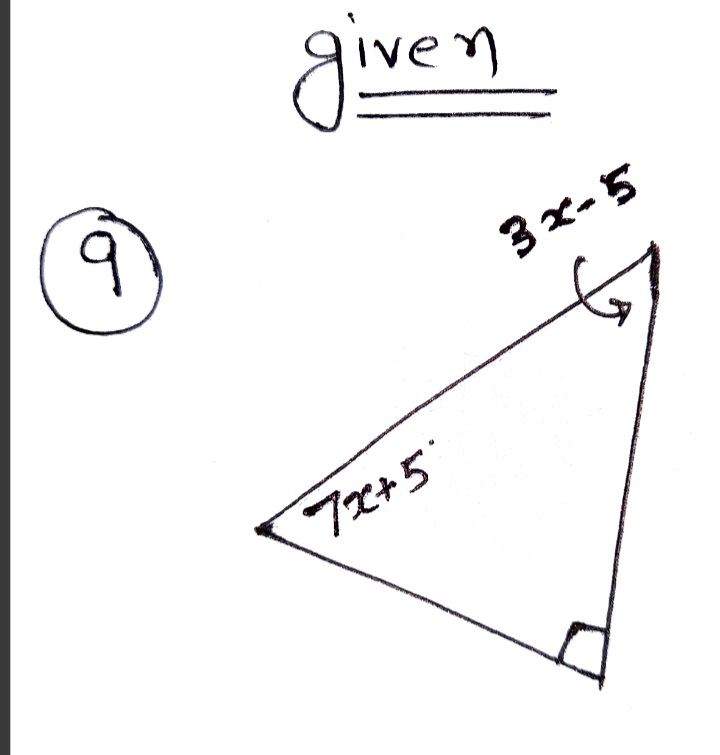Elementary Geometry For College Students, 7e
7th Edition
ISBN:9781337614085
Author:Alexander, Daniel C.; Koeberlein, Geralyn M.
Publisher:Alexander, Daniel C.; Koeberlein, Geralyn M.
ChapterP: Preliminary Concepts
SectionP.CT: Test
Problem 1CT
Related questions
Question
![**Title: Understanding Triangle Angle Relations**
**Introduction:**
This educational material focuses on solving problems related to triangle angle measures and algebraic equations.
**Instructions:**
- Find the value of \( x \) for each of the given geometric problems involving triangles.
**Example Problem:**
1. **Problem Statement:**
- A triangle is presented with angle expressions in algebraic form, such as \( (3x - 11)^\circ \) and \( (20x - 3)^\circ \). The goal is to find the value of \( x \).
2. **Solution Process:**
- **Equation Setup:**
- Use the triangle sum property: the sum of angles in a triangle is \( 180^\circ \).
- Set up the equation based on given angles. For example:
\[
11x - 1 + 20x - 3 = 151
\]
- **Simplification:**
- Combine like terms:
\[
31x - 4 = 151
\]
- Add 4 to both sides to isolate terms with \( x \):
\[
31x = 155
\]
- Divide by 31:
\[
x = 5
\]
3. **Graphical Representation:**
- Diagrams accompanying the problems illustrate triangle configurations, angles marked with algebraic expressions, and known angle values, such as \( 151^\circ \).
- Each triangle graph provides necessary visual aid to apply the triangle sum property related to the angles.
**Conclusion:**
This set of problems is designed to reinforce understanding of the relationships between angles in triangles and how they can be expressed and solved using simple algebraic equations. Solving these problems involves establishing equations based on the angle sum property of triangles and solving for \( x \).](/v2/_next/image?url=https%3A%2F%2Fcontent.bartleby.com%2Fqna-images%2Fquestion%2Ff25d6424-d40b-438b-8a31-4a3e0a11a023%2Fb99272cf-427d-4bfd-b22f-e69385bac3ce%2Fdsidqkw_processed.jpeg&w=3840&q=75)
Transcribed Image Text:**Title: Understanding Triangle Angle Relations**
**Introduction:**
This educational material focuses on solving problems related to triangle angle measures and algebraic equations.
**Instructions:**
- Find the value of \( x \) for each of the given geometric problems involving triangles.
**Example Problem:**
1. **Problem Statement:**
- A triangle is presented with angle expressions in algebraic form, such as \( (3x - 11)^\circ \) and \( (20x - 3)^\circ \). The goal is to find the value of \( x \).
2. **Solution Process:**
- **Equation Setup:**
- Use the triangle sum property: the sum of angles in a triangle is \( 180^\circ \).
- Set up the equation based on given angles. For example:
\[
11x - 1 + 20x - 3 = 151
\]
- **Simplification:**
- Combine like terms:
\[
31x - 4 = 151
\]
- Add 4 to both sides to isolate terms with \( x \):
\[
31x = 155
\]
- Divide by 31:
\[
x = 5
\]
3. **Graphical Representation:**
- Diagrams accompanying the problems illustrate triangle configurations, angles marked with algebraic expressions, and known angle values, such as \( 151^\circ \).
- Each triangle graph provides necessary visual aid to apply the triangle sum property related to the angles.
**Conclusion:**
This set of problems is designed to reinforce understanding of the relationships between angles in triangles and how they can be expressed and solved using simple algebraic equations. Solving these problems involves establishing equations based on the angle sum property of triangles and solving for \( x \).
Expert Solution
Step 1: Given problem

Step by step
Solved in 3 steps with 2 images

Recommended textbooks for you

Elementary Geometry For College Students, 7e
Geometry
ISBN:
9781337614085
Author:
Alexander, Daniel C.; Koeberlein, Geralyn M.
Publisher:
Cengage,

Elementary Geometry for College Students
Geometry
ISBN:
9781285195698
Author:
Daniel C. Alexander, Geralyn M. Koeberlein
Publisher:
Cengage Learning

Elementary Geometry For College Students, 7e
Geometry
ISBN:
9781337614085
Author:
Alexander, Daniel C.; Koeberlein, Geralyn M.
Publisher:
Cengage,

Elementary Geometry for College Students
Geometry
ISBN:
9781285195698
Author:
Daniel C. Alexander, Geralyn M. Koeberlein
Publisher:
Cengage Learning